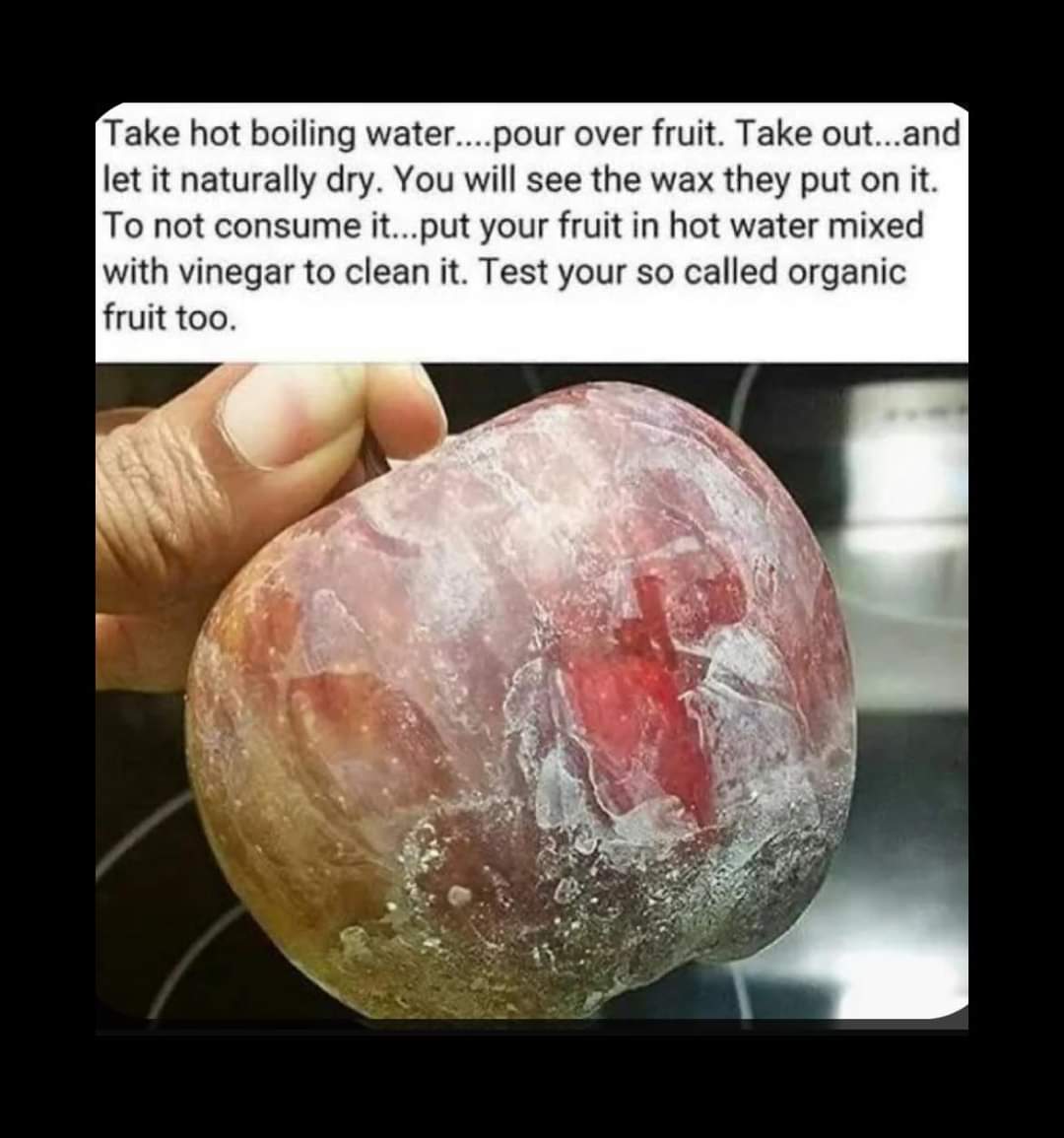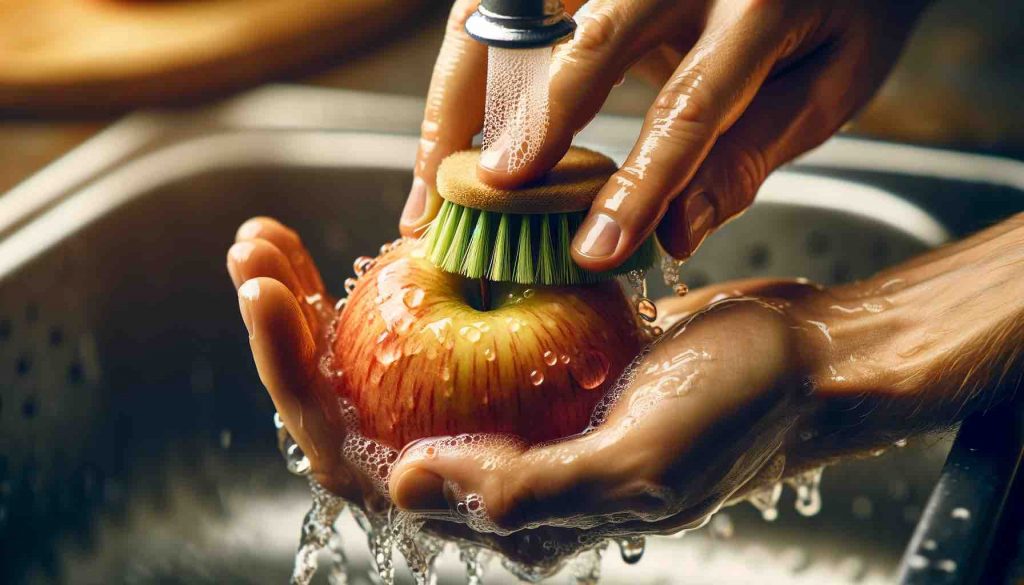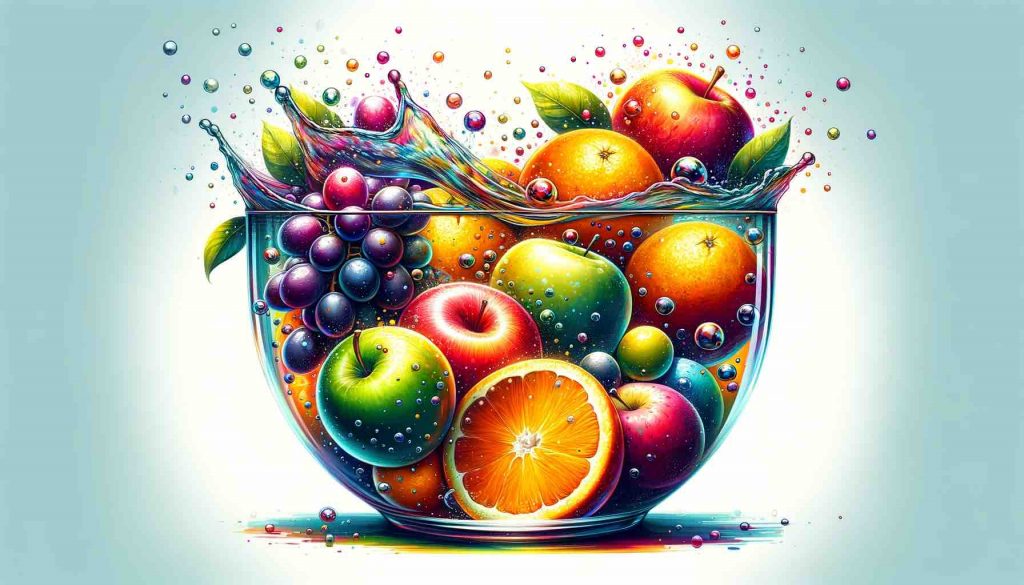
Introduction
Have you ever wondered why the apples at your grocery store have that alluring, glossy sheen? Or perhaps, why your lemons feel a tad slippery even before you slice them? The answer lies in a little-known secret: the invisible coat of wax. While this shiny veneer might make fruits look more appealing on the shelf, it raises important questions about what we’re actually consuming along with our daily fruit intake.
Welcome to “Unwaxing the Truth: How to Clean Your Fruits” – a revealing guide designed to demystify the world of fruit wax. Here, we delve into not only the ‘what’ and ‘why’ of waxing but also the ‘how’ of effectively removing it to ensure that what you bite into is as nature intended – pure, clean, and healthy.

So, are you ready to peel back the layers of truth and discover how to enjoy your fruits in their most natural state? Let’s embark on this eye-opening journey together, one shiny apple at a time.
[ez-toc]
Section 1: The Hidden Coating – Understanding Fruit Wax
What is Fruit Wax?
Fruit wax is nature’s clever packaging material, but what we see on store shelves often isn’t just the natural kind. Commercially, an additional layer of wax is applied to fruits after harvest to preserve freshness, enhance appearance, and extend shelf life. This wax is not just a cosmetic enhancement; it plays a crucial role in preventing moisture loss and protecting fruits from bruises and bacteria during transportation.
Why is Fruit Wax Used?
Imagine a world where apples bruise easily and cucumbers lose their crispiness rapidly. That’s a world without fruit wax. The wax coating acts as a barrier, sealing in moisture and keeping the produce fresh for longer. It’s a common practice in the food industry, meant to ensure that the fruits survive the journey from farm to your fruit bowl looking and tasting their best.
Common Waxed Fruits
While not all fruits receive a wax treatment, some common candidates include apples, cucumbers, lemons, oranges, and limes. Each of these is chosen for specific reasons – for apples and cucumbers, it’s about retaining moisture; for citrus fruits, it’s also about enhancing their vibrant appearance.
Health Implications
The big question is – is this wax safe? Waxes used on fruits are food-grade and deemed safe by food safety authorities. However, some people prefer to remove the wax for a more natural taste, to reduce chemical exposure, or simply for peace of mind.
Also note it depends on where you are buying your fruit from, in less regulated markets like India, you can never be sure about the quality or quantity of wax or wax-like substance that would be used on such fruits.
Section 2: Unveiling the Truth – Types of Waxes
Natural vs. Synthetic Waxes
Not all waxes are created equal. In the fruit industry, there are two primary types of waxes: natural and synthetic. Natural waxes, such as beeswax, carnauba wax, and shellac (derived from secretions of the lac bug), are commonly used on organic produce. On the other hand, synthetic waxes, often petroleum-based, are used for conventional fruits. While both types are considered safe for consumption, the choice of wax can influence the removal method.
Organic vs. Conventional Fruits
It’s a common misconception that organic fruits don’t undergo waxing. In reality, they do, but the waxes used are natural and comply with organic standards. This distinction is crucial as it underscores the fact that regardless of whether a fruit is organic or conventional, consumers may still want to consider cleaning methods to remove wax.
The Waxing Process
Understanding the waxing process can shed light on why removing it might be beneficial. After harvesting, fruits are cleaned, which often removes their natural waxes. The external wax coating is then applied to replace the lost natural protection. This wax layer can sometimes trap residues or contaminants, which is one reason why removal is recommended for those seeking the purest form of their fruits.
Section 3: The Cleaning Guide – Techniques to Remove Wax
General Cleaning Tips
Before diving into specific methods, remember these general cleaning tips: Always wash your hands before handling fruits and vegetables, and ensure that any brushes or towels used are clean to avoid cross-contamination.
Method 1: Boiling Water
- Procedure: Bring water to a boil in a large pot. Submerge the fruit for about 10 seconds, then immediately remove it.
- Effectiveness: This method loosens the wax, making it easier to wipe off.
- Best For: Sturdy fruits like apples and pears.
- Cautions: Avoid using this method for soft or porous fruits as the heat can damage them.
Method 2: Baking Soda and Vinegar/Lemon Juice
- Procedure: Mix hot water with baking soda and vinegar or lemon juice in a large bowl. Soak the fruit for 5-10 minutes, gently scrubbing if needed.
- Effectiveness: Baking soda and vinegar/lemon juice combination helps to break down the wax.
- Best For: Fruits with thicker skins like cucumbers or citrus fruits.
- Cautions: Ensure thorough rinsing to avoid any taste of vinegar or lemon juice on the fruit.
Method 3: Apple Cider Vinegar
- Procedure: Dip a clean dish towel into apple cider vinegar and gently rub the fruit’s surface.
- Effectiveness: Apple cider vinegar is effective in breaking down both natural and synthetic waxes.
- Best For: Most types of fruits, especially those with smoother surfaces.
- Cautions: Some fruits might absorb the vinegar smell, so a final rinse with water is recommended.
Additional Considerations
While these methods are effective at removing wax, they also remove some pesticides and surface contaminants. However, it’s important to note that no method can remove all pesticide residues.

Section 4: Myth Busting – Common Misconceptions About Fruit Wax
Myth 1: “All Wax is Harmful”
- Reality: The truth is, most waxes used on fruits are food-grade and considered safe by food safety authorities. The concern arises more from what the wax traps (like pesticides) rather than the wax itself.
Myth 2: “Washing with Water is Enough”
- Reality: Simple rinsing with water may not be sufficient to remove wax coatings. Specialized methods, like the ones described earlier, are often necessary to effectively break down and remove the wax.
Myth 3: “Organic Fruits Don’t Have Wax”
- Reality: Organic fruits often do have wax coatings, but these are natural waxes compliant with organic standards. However, like conventional waxes, they can also trap residues and may need to be removed.
Myth 4: “Wax Removal Affects Nutrient Content”
- Reality: Removing wax from the surface of fruits does not significantly affect their nutritional value. The nutrients are predominantly within the fruit, not in the wax coating.
Myth 5: “All Fruits Are Waxed Equally”
- Reality: Different fruits receive different types of wax applications and in varying amounts. For example, apples might have a thicker wax coating compared to something like plums.
Section 5: Beyond Cleaning – Additional Benefits of Unwaxed Fruits
Enhanced Nutritional Intake
- While the wax on fruits doesn’t directly affect their nutrient content, unwaxed fruits may offer a more natural taste and texture, potentially encouraging increased fruit consumption. More fruits in the diet can lead to a better intake of essential vitamins and minerals.
Improved Taste and Texture
- Many people find that fruits taste better without the wax coating, as it can sometimes impart a slight artificial texture or interfere with the natural flavor profile of the fruit. Experiencing fruits in their most natural state can enhance the overall eating experience.
Environmental Considerations
- Choosing to remove wax from fruits also aligns with environmentally conscious practices. By reducing the consumption of synthetic materials like petroleum-based waxes, you contribute to a more sustainable and eco-friendly lifestyle.
Mindful Eating
- The process of cleaning and preparing your fruits can foster a more mindful approach to eating. It encourages awareness of what you consume and how it impacts your health, leading to more informed and health-conscious choices.
Section 6: Practical Tips – Storing Your Cleaned Fruits
Proper Storage Techniques
- After removing the wax and cleaning your fruits, storing them correctly is essential to maintain freshness. Different fruits have different storage needs – some do best in a cool, dry place, while others require refrigeration.
Drying Before Storage
- Ensure that fruits are completely dry before storing to prevent mold growth and spoilage. Use a clean cloth or paper towel to gently pat them dry.
Separate Storage
- Store strong-smelling fruits away from other produce to prevent flavor transfer. For example, keep onions and garlic away from apples and pears.
Breathable Containers
- Use breathable containers or bags for storage. This helps to circulate air and keeps the fruits from becoming damp, which can lead to quicker spoilage.
Regular Checks
- Regularly check stored fruits for any signs of spoilage or overripeness and remove them promptly to prevent them from affecting other fruits.
Do’s and Don’ts
- Do label your storage containers with dates for better tracking.
- Don’t store fruits in airtight containers as this can speed up decay.
- Do keep fruits that ripen quickly away from those that don’t.
- Don’t wash fruits before storing them unless you plan to consume them soon.
Conclusion
Recapping the Journey
We’ve embarked on an enlightening journey through the world of fruit wax – from understanding its purpose to mastering the art of removing it. You’ve learned not only the hows but also the whys of dealing with waxed fruits, equipping you with the knowledge to make healthier and more informed choices.
The Impact of Knowledge
Armed with these insights, you can now approach your fruit consumption with a new perspective. Whether it’s savoring the enhanced natural flavors of unwaxed fruits, embracing eco-friendly practices, or simply enjoying the peace of mind that comes with eating cleaner, safer produce – the benefits are numerous and significant.
A Call to Action
We encourage you to put these methods into practice. Experiment with the different cleaning techniques and discover what works best for you and your favorite fruits. Share your experiences and insights with others, spreading the knowledge of how simple steps can lead to healthier eating habits.
Parting Thoughts
As you enjoy your next piece of fruit, remember that every bite is an opportunity to nourish your body and connect with the natural world. Let “Unwaxing the Truth: How to Clean Your Fruits” be a guide to a more mindful and healthful way of living, one fruit at a time.
10 FAQs for “Unwaxing the Truth: How to Clean Your Fruits”
- What is the purpose of wax on fruits? Wax is applied to fruits to preserve freshness, reduce moisture loss, protect from bruising, and enhance appearance. It’s a standard practice in the fruit industry.
- Are all fruits waxed in the same way? No, different fruits receive varying types and amounts of wax. For instance, apples often have a thicker wax coating than plums.
- Is fruit wax harmful to consume? Most fruit waxes are food-grade and considered safe by food safety authorities. The concern is more about what might be trapped under the wax, like pesticides.
- Can I remove wax from all types of fruits? Yes, you can remove wax from most types of fruits, but the method may vary depending on the fruit’s texture and type of wax used.
- Does washing fruits in plain water remove the wax? Simply rinsing with water is usually not enough to remove wax coatings. Specific methods like using vinegar or baking soda are more effective.
- How can I remove wax from organic fruits? Organic fruits often use natural waxes, which can be removed using methods like soaking in vinegar solutions or using apple cider vinegar.
- Does removing wax from fruits affect their nutritional value? No, removing wax does not significantly impact the nutritional content of the fruit, as nutrients are primarily within the fruit.
- Can removing wax from fruits improve their taste? Many people find that fruits taste better without the wax coating, as it can sometimes affect the natural flavor and texture.
- What are some simple methods to remove wax from fruits at home? Boiling water, baking soda and vinegar/lemon juice mix, and wiping with apple cider vinegar are effective home methods.
- After removing wax, how should I store the fruits? Store fruits in breathable containers or bags, ensure they are dry, and place them in suitable conditions (some in a cool place, others refrigerated).
Blog Tags for the Post
fruit wax removal, natural fruit cleaning, DIY fruit wash, organic produce care, healthy eating tips, food safety, home remedies, sustainable living, eco-friendly practices, mindful eating








